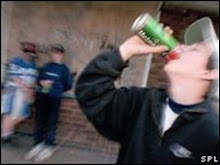The desired impact of crown corporations (ie.LCBO) in regards to youth drinking is employ strict control of youth access to alcohol. To what extent does a monopoly of alcohol distribution actually prevent alcohol consumption in youths? The following statistics display the amount of individuals who report consuming 5 or more alcoholic drinks at one time, 12 or more times per year. The percentages are divided according to age groups in years:
12-14: 4.2%
15-19: 31.1%
20-24: 44.5%
25-34: 26.6%
(Statistics Canada, 2007)
These statistics are difficult to analyze because the drinking age is included as a parameter within one of the age groups. Are 1/3 of 15 year olds consuming alcohol? Or does this percentage reflect the youth who are able to purchase alcohol (19 year olds)?
The frequency of drinking between individuals who are 15-19 and 20-24 are greater than those between 20-24 and 25-34. It appears that our highly controlled system of sales does prevent youth from accessing alcohol. However, the LCBO reports that in 2006/2007, 100 860 underage youth attempted to purchase alcohol at an LCBO. To truly understand the extent to which these crown corporations prevent alcohol sales we would need to compare these statistics to those within a totally privatized system to serve as a control group.
The un-intentioned impact of our monopolized system includes illegal means to acquire alcohol and the stigma that is placed on youth who attempt to purchase alcohol. The LCBO and its consumers are highly focused on preventing alcohol sales to youth much more than other alcohol-related issues. There is much effort and money put into these campaigns that maintain the image of youth who drink as irresponsible, deviant, and requiring adult protection. The greater the efforts to prevent sales to alcohol, the wider the gap grows between the perceived beliefs and behaviours of youth and those of adults.
Subscribe to:
Post Comments (Atom)


No comments:
Post a Comment